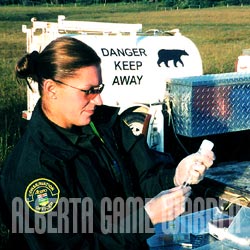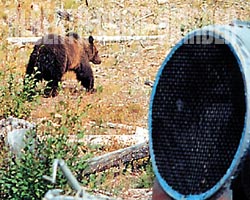
The Life of a Bear
Frank deBoon
Under the cover of darkness the bear silently stalked
to the edge of the clearing. Senses fully alert, it lay down under a
spruce tree and studied the bare moonlit expanse.
The night before, the clearing had been filled with
activity. There had been a large group of people with campers, tents
and vehicles scattered about. The scents and sounds of them had roused
the bear's curiosity. The wind had carried the scent of various foreign
food sources to the bear's sensitive nose. Although they were inviting,
the smell of humans and the strange noises they made kept the bear at
bay.

In the can: A conservation
officer prepares a dose of immobilizing
drug for a trapped problem bear. Photo by Keith Linderman.
Now, as he lay watching the silent clearing, the breeze
again carried a number of familiar and foreign scents. Across the clearing,
along the stream bank, the familiar smell of the heads and offal of
a number of fish revealed where they lay in the grass. A shift in the
breeze brought the scent of some unfamiliar food, scraped off plates
along the edge of the clearing. A half-filled beer can provided another
tantalizing smell. And the bacon grease, coating a rock on the side
of the fire pit, was irresistible.
The bear rose and took a cautious, silent step into
the clearing. Senses fully alert, he was ready to flee at the first
hint of danger. The sudden rustle of a squirrel nearly sent the bear
into flight. Alert and on pins and needles, the bear sidled over to
the bacon grease.
He eyed the woods all around the clearing before the
scent of the bacon overcame his caution, and he began to lick the rock.
Slowly, methodically, the bear searched out all the various food sources
in and around the clearing.

Chance of a lifetime: A
grizzly makes tracks for bear country
after being released from a culvert trap. Photo by Frank deBoon
A week later, he lay again on the edge of the clearing.
The people had returned and stayed overnight, before leaving earlier.
Cautiously and under the cover of darkness, the bear again sought out
and fed on the various food sources scattered around the clearing.
Another week passed and the campers had come and gone.
The bear did not even wait now until it was completely dark before searching
out the now-familiar food smells.
In his travels, the bear had often gone by farmhouses
and outbuildings. In the past he had given them a wide berth. Now, as
he became more familiar with the scent of humans, he began to approach
the buildings in search of food.
His first forays near buildings were under the cover
of darkness. The pet food, garbage and other food sources he obtained
during these late night raids encouraged the bear to return and seek
out food at other residences.
He became bolder and began to increase his activities around human settlements.
The more successful his raids, the bolder he became. His raids began
to occur during early morning and late evening daylight hours.
The contacts the bear had with people became more
frequent. The first few times, the bear ran away from their shouts and
other noises. Each time the distance decreased. No harm had come to
him. Although he continued to keep some distance between him and any
people he encountered, he was not overly concerned about being in view.
Humans were an annoyance. He could tolerate their presence though, in
order to obtain the food he associated with them.
The bear became adept at opening garbage cans and
prying open other containers to obtain food. One evening the bear returned
to a residence where he had found food the two previous evenings. A
large barrel-like object he had not seen before was along the trail
he used to get to the garbage cans.
The bear circled the object to find a way to get at
the food he could smell inside. He went into a large opening and ate
some scraps off the floor, before he came to the bait hanging from the
roof of the trap. He grabbed the bait in his teeth and gave it a tentative
pull. The bait gave a little and he heard a loud bang as the door closed
behind him.
Frightened, the bear let out a loud roar and tried
to find his way out of the trap. He clawed and scratched but was unable
to find a way out. For the first time in his life he was trapped. He
could not come and go at will.
A short time later, people began to gather around and peer at him through
the holes in the trap. The bear growled, spit and charged at the people,
but they were just out of reach and he could not escape.
He felt a slight stabbing pain and began to feel drowsy.
He lost his balance and fell, got up and fell a few more times until
he could no longer control his own movements.
He could see what was happening to him and around
him, but he was unable to coordinate his muscles and make his escape.
Colored tags were placed in his ears. The trap door was closed again
and the trap began to move.
For several hours the trap moved across the ground.
The bear regained the mobility of his muscles and could stand and control
his movements. But he still could not escape. Eventually, the trap door
was opened and the bear was able to escape. At first, the bear ran just
to put distance between him and the trap. When he slowed down, he again
began to search for food.
Instinct told the bear the shortest route of return
to the place where he had been trapped. As he began his journey, his
relentless search for food continued. At an old campsite he again found
scraps of food where humans had discarded them. As he followed a stream
he found more campsites and more food. He stopped to feed in an area
lush with berries and was driven off by another bear. He fed off the
remains of a road-killed deer for a couple of days before being driven
off by a sow with cubs.
The bear continued on, until he was again in his old
territory. He began to visit all of his old haunts to obtain food from
his former sources. The culvert trap was again set near some of the
residences the bear visited on a regular basis. Although the scent of
the food inside the trap was inviting, his previous experience made
the bear avoid it.
A few nights later, he approached some food partly
hidden in the trees. As he stepped over a log, a steel cable sprang
up and encircled his lower front leg. The bear tried to pull away and
the cable tightened. Although he could move a few feet away from the
tree, the cable tied him to it and he could not escape. For the second
time in his life the bear was trapped.
People arrived and the bear felt a hard blow to the
large muscles of his right hip. He began to feel drowsy and lost control
over his muscles. Once immobile, he was loaded into a culvert trap.
The trap moved and the distance it traveled was double that of the bear's
first trip.
Once more the bear was released and began his homeward
journey. Along his route, he again found numerous food sources near
campsites, cabins and residences. Whenever he would stay in one place
for any length of time he would come into conflict with other bears
and be rudely sent on his way.
Eventually the bear returned to his old territory.
Another smaller bear had moved in but he had no difficulty in chasing
away the interloper. He returned to his old routine of finding food
near residences and outbuildings. The garbage cans, pet food, BBQs and
other food sources were nearly always found in the same locations each
time the bear visited. Feeble efforts to deter the bear had little effect.
Rocks placed on garbage can lids were easily removed. When garbage or
other food was stored inside old sheds, the bear would either push in
the doors or tear them down.
One afternoon as the bear was making his rounds, a
vehicle pulled up on the street a short distance away. A human carrying
a stick got out and walked toward him. Although not overly concerned,
the bear kept his distance. He walked away from the residences and stood
along the tree line.
The human raised the stick and another problem bear
died.
A problem bear is a bear habituated to feeding on
human food sources such as pet food, garbage, BBQs, fruit trees and
dead livestock, and has lost its natural fear of people.
Each problem bear's life history may vary. Some might
obtain food from a landfill, from around a residence or from dead livestock
or wild game carelessly discarded near residences. Problem bears are
generally a result of human carelessness or ignorance. Food may be available
to bears either by accident or in the belief that feeding bears will
benefit them.
Unfortunately, once a bear learns to associate people
with food it will actively search for food around them and may become
aggressive in obtaining food. It is then a threat to human safety and
property.
Depending on the circumstances of the bear problem
and other factors (bear population, available relocation sites) a bear
may be relocated once, twice or not at all before being destroyed. When
a problem bear is destroyed, the blame for the bear's death is often
placed on the person whose responsibility dictates he or she must destroy
the bear to ensure the safety of humans and their property. The real
cause of the problem bear and its death is not addressed. The problem
bear is replaced by another, continuing the cycle.
Frank deBoon is a Conservation Officer in Fernie, British
Columbia.
|